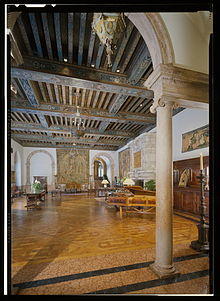Concert in E flat for chamber orchestra "Dumbarton Oaks"
Igor Stravinsky wrote the concerto in E flat major for chamber orchestra "Dumbarton Oaks" between summer 1937 and spring 1938 as, in his own words, a "small concerto in the style of the Brandenburg Concerts ". He had received the order for this from the American art patrons Robert Woods Bliss and his wife Mildred Barnes Bliss, who wanted to celebrate their 30th wedding anniversary with it; Dumbarton Oaks is the name of their mansion near Washington, DC
description
The instrumentation with a transverse flute , a clarinet in Bb, a bassoon , two horns in F, three violins , three violas , two cellos and two double basses , which are used both as soloists and in different groups, is reminiscent of baroque concerti grossi . In particular, there are parallels between the first movement by Dumbarton Oaks ( Tempo giusto ) and the first movement of the 3rd Brandenburg Concerto; this is occupied by 3 violins, violas and cellos as well as a double bass, which also appear partly as soloists and partly in equal groups. The two sentences are also similar thematically. In the second movement ( Allegretto ) of Stravinski's concerto, the line-up is reduced by the horns and basses, which emphasizes his delicate rhythmic figures even more. The third movement, which is again fully occupied, is characterized by ostinate elements and strong contrasts between the tutti and solo sections.
Nadia Boulanger conducted the private premiere of the concert on May 8, 1938 at Dumbarton Oaks , as Stravinsky was unable to attend due to tuberculosis therapy. The composer stood at the podium at the public premiere in Paris on June 4th .
